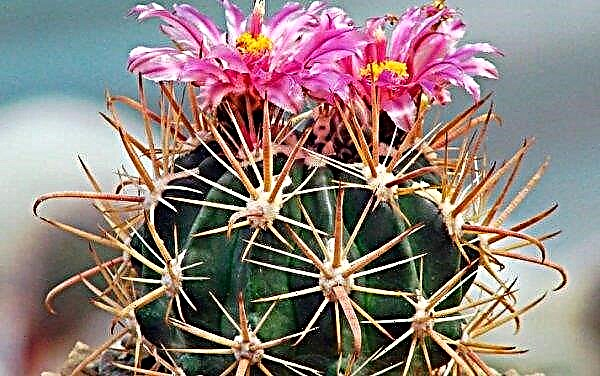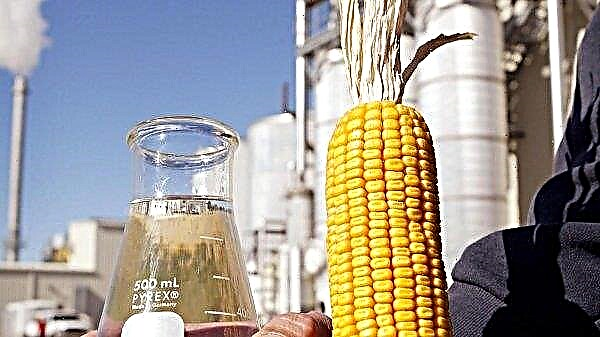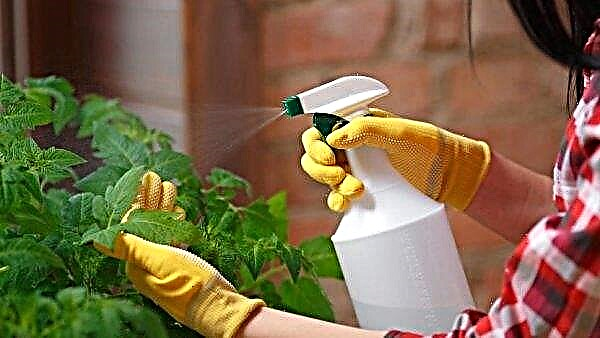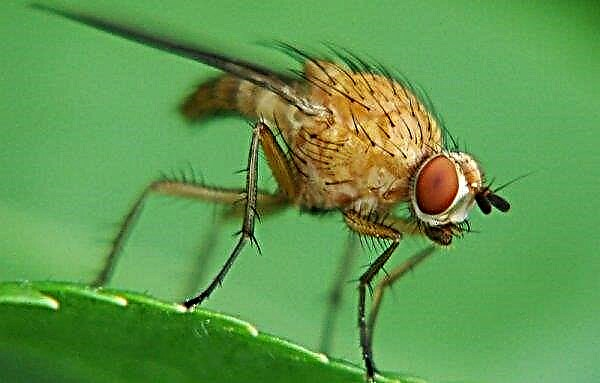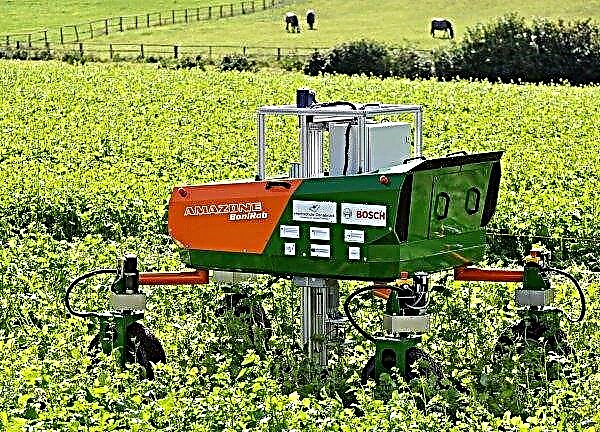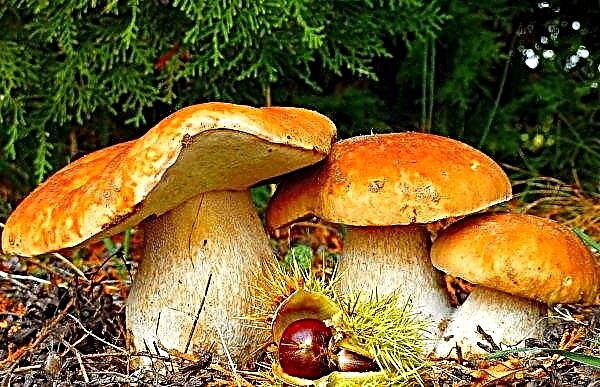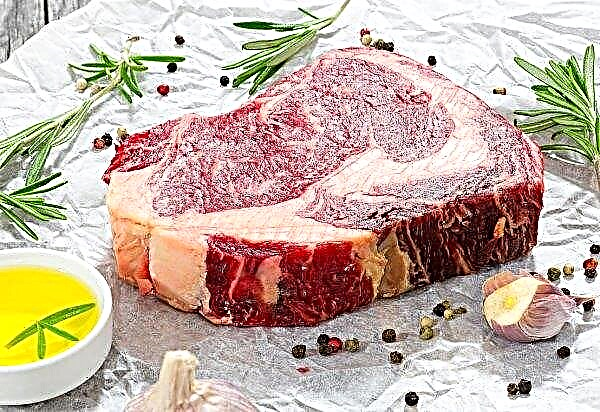Prickly spruce Montgomery (Picea pungens Montgomery) - classic blue, designed for growing in large gardens and arboretums. This is a slowly growing dwarf selection tree with a wide pyramidal shape. In the article you will find information about the indicated variety, as well as the conditions for its cultivation.
Botanical Description
The variety was originally a seedling selected in the early 30s in the Eastern nursery of Massachusetts, USA. It was acquired by collector and owner of several nurseries R.H. Montgomery from Greenwich, Connecticut, and named after himself. The plant was grown and marketed under the name RH Montgomery.
 The spruce of the described variety has a spherical shape at the stage of a young seedling.
The spruce of the described variety has a spherical shape at the stage of a young seedling.
But with age, the central shoot begins to grow, and the tree takes on a pyramidal shape. It can reach a height of 4.5 m. The diameter of the lower part of the spruce can grow up to 3.8 m. Montgomery is often confused with another cultivar of blue spruce - the Globosa variety.
Montgomery is considered a classic representative of the considered type of coniferous trees. This is a dwarf selection, not very intensively growing: over 10 years, a seedling will grow only to a height of 1.5 m and a width of 1 m. The annual growth rate of a tree is about 6 cm and under good conditions does not exceed 15 cm.Did you know? The original plant, which was acquired by Montgomery and propagated, still grows in the New York Botanical Garden.
Description of spruce:
- needles: bright, blue;
- needle length: up to 20 mm;
- shoots: yellow-brown;
- shade tolerant;
- hardy;
- Suitable for growing both in the ground and in containers.
Landscape design application
Blue spruce is used in garden design by many gardeners. It is perfect for all styles. And its needles, kidneys and pollen have useful healing properties and can be used as a general strengthening agent if brewed in the form of tea.
Main uses:
- Most often, spruce trees are planted along the tracks or used as an element to create an alpine hill. The beautiful blue hue of the branches allows them to function as the focal point of the composition.
- Blue spruces are often used as holiday New Year trees. In this case, they are planted where they will best decorate your site and will create a festive mood, including for passers-by.
- Seated in a row, they form a living wall to reduce the effects of gusts of wind, protecting more delicate garden plants.
- The combination of large and small fir trees during planting will serve as a visual screen for marking the boundaries or creating a secluded area in the garden.

If we consider spruce from the point of view of the combination of colors, then in a small courtyard a combination of warm and cool shades can change the perception of depth. Put warm flowers in the foreground. Behind them are plants of cool shades, from blue to dark purple, and again turn to light ones. This creates the illusion of depth, and also visually increases the size of the flowerbed.
Compositions with blue spruce:
Selection and preparation of a landing site
Space plays a huge role in deciding whether to plant blue spruce trees. You need a plot in which the tree will be spacious, and it will not interfere with other plants.
When inspecting the area, consider the following:
- Mark for yourself the places where the tree is best able to demonstrate its decorative properties.
- Direction of the wind. Spruce itself tolerates any wind well, but it can be used to create a barrier to a more heat-loving plant - for example, peach or roses.
- Bright sunlight is required. But at the same time, blue spruce grows well in conditions of partial shade. In addition, it can create shading for flowers that need it in the afternoon. This property of the tree is always taken into account when creating plant compositions.
- Need a site with moist, well-drained fertile soil.
Important! The blue shade of the needles is achieved thanks to a wax coating. But the needles may lose their color due to external infection by pine weevils or fungal diseases.
Start preparing for planting by mowing the grass in the planting zone to the shortest possible size. Then sprinkle it with water and cover with a layer of dark polyethylene corresponding to the contours of the landing site.
With moderate exposure to the sun, the earth under it will heat up to 60 ° C, and this will destroy grass, seeds that can germinate, as well as soil bacteria. After about 4 weeks, the grass will die completely.
 Now it can be dug with the soil, forming a compost useful for seedling nutrition.
Now it can be dug with the soil, forming a compost useful for seedling nutrition.
If you are not sure about soil drainage at the planting site, check this:
- Dig a hole measuring 35 × 35 cm.
- Fill it with water, let it drain.
- Now refill.
- If the soil is well drained, after 2 hours the water should completely leave.
 As for the level of acidity, then spruce needs soil from 6.0 to 7.5 pH. But she will well tolerate other types of soil. Most garden soils range in pH from 6.0 to 7.0.
As for the level of acidity, then spruce needs soil from 6.0 to 7.5 pH. But she will well tolerate other types of soil. Most garden soils range in pH from 6.0 to 7.0.
Phased landing
Landing technology in stages:
- Prepare the landing pit. It should be 2 times wider than the root ball. This is necessary in order to weaken the soil on the sides and to enable better development of the roots that will form.
- Put the soil removed from the pit to one side. Depending on the type, it needs to be changed. If clay - add sand and compost in equal proportions. If it’s sandy, then, on the contrary, weight it with clay so that the water does not leave too quickly and the tree does not suffer from drought.
- Remove the spruce from the container in which it arrived from the nursery. To do this, gently lift the barrel above it, but do not pull too much. If the root ball is stuck, use a knife to loosen it on the sides.
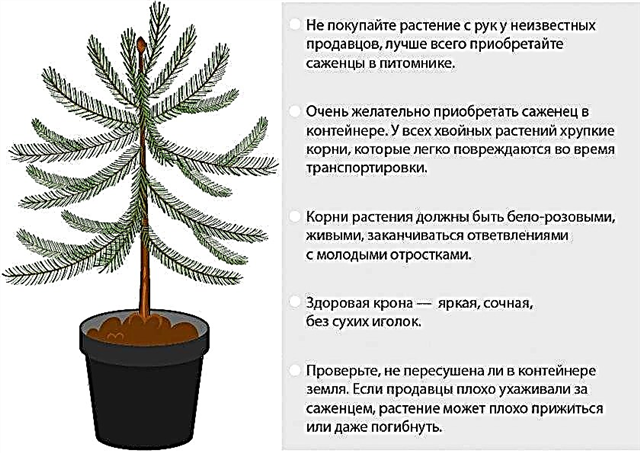
- Place the root ball so that the tree is at the same level that it grew in the nursery. If necessary, add soil under the roots to achieve the correct height.
- Hold the barrel and fill the pit with soil. The tree should have sufficient oxygen access to the root, so make sure that the soil layer above the root ball is as thin as possible.
- If the spruce grows away from the water source, then the remaining planting mixture is used to create an embankment up to 7 cm high around the planting pit (water collector). This will help to collect water after irrigation or rain, using it for the needs of the plant.
- Deep water the landing zone. You can add a root growth stimulator to irrigation water, which will help the tree to take root.
- To preserve soil moisture and inhibit weed growth, apply a layer of chopped wood mulch or pine needles on top. Replace it is recommended after six months. During this time, wood will return to the soil the beneficial substances accumulated in it.
 Try not to put the mulch directly at the base of the tree, as this can lead to rotting of the bark on the trunk.
Try not to put the mulch directly at the base of the tree, as this can lead to rotting of the bark on the trunk.Care Features
Blue spruce is extremely easy to care for.
But still, you need to remember some rules when growing it:
- The tree does not need to be fed, but gardeners advise nevertheless to conduct it once a year in the spring.
- Be sure to remove dry branches if they have formed. But before cutting, scrape the bark with the back of the knife. If there is a dead, dry surface under it, then it can be cut off.
- During periods of drought, water the plant - it needs moderately moist soil.
- Be sure to trim, as this procedure helps the tree maintain its lush beautiful shape.
Watering and feeding
When a tree is rooted, it becomes resistant to drought. But the young seedling needs regular watering in order to form the root system. Of course, the soil should not be constantly moist, otherwise it will cause root rot and other harmful diseases.

Highlights in watering:
- Immediately after planting, the soil should be intensely moistened to stimulate early root formation. Since the spruce roots are poorly rooted, add a solution of “Heteroauxin” 0.002% at the rate of 5 liters per plant. Watering is repeated several times per season. You can also use "Radifarm" - 25 ml of the active substance is dissolved in 10 l of water. The flow rate of the solution per plant will be 0.3-0.5 liters. Watering is repeated again after 14 days. The use of stimulants can reduce the shock for spruce from transplantation.
- During the growth period, water immediately, as soon as the soil dries to a depth of 5 cm. If it rains, then additional watering is not required.
- It is better to water less often, but soaking the soil to a greater depth. This will speed up the access of water to the plant. Moisture, which is at a depth, will slowly evaporate, which is also good for the development of a tree.
- When an adult tree has taken root, there is no need for irrigation. The exception is periods of summer drought.
- When growing in a container, check the soil and water if its top 5 cm has dried out. Container plants are often watered, as they cannot receive additional moisture from the soil outside their planting capacity.
- With automatic watering, set the timer for the morning hours. Evening irrigation is undesirable, as it contributes to the development of fungal diseases.
Did you know? The life span of blue spruce ranges from 150 to 600 years.
A couple of years after planting under a tree, the amount of nutrients that you introduced at the time of planting is reduced. And if the soil was not too fertile, then it is necessary to feed it. Do it 3 times a year: in spring, summer and autumn.
To do this, you can buy 2 types of fertilizers in the store:
- spring-summer with a large amount of nitrogen necessary for the growth of branches and the development of green mass;
- autumn, with a high amount of potassium.
 For example, Florovit is applied in the spring in an amount of 10–20 g, depending on the size of the tree. It can be diluted with water or mixed with soil. In September, the same preparation can be applied at a reduced rate of 5-15 g per spruce.
For example, Florovit is applied in the spring in an amount of 10–20 g, depending on the size of the tree. It can be diluted with water or mixed with soil. In September, the same preparation can be applied at a reduced rate of 5-15 g per spruce.
Shaping and trimming
The main purpose of pruning is to preserve the natural beauty of the plant. In order to understand its appropriateness, pay attention to how the branch develops. First, a kidney awakens on the trunk and shoots. Every year a new growth will appear in its upper part.
As the length of the needles increases, that part of the branch that is closer to the trunk will age and crumble. The result is a long shoot, green at the end and devoid of needles inside. To avoid this, you need to limit the growth by pinching the top: so you save the needles and reduce the space that the plant could occupy on the site.
Important! Sprinkle fertilizer granules away from the trunk. And be sure to water the tree plentifully so that they soak.
Sanitary pruning is carried out at the end of winter. At this time, old and damaged branches are removed. Fungi and wood pests can settle in dry branches, so trimming them will help the plant stay healthy.

The natural form of blue spruce is a pyramid. It is easier to maintain if you are doing the molding trimming. Perform it by pinching the apical shoot in May, which allows you to adjust the length of the branches. In addition, pinching stimulates the development of buds located on the same branch. Next year, new needles will appear from them.
It is also sometimes necessary to thin out a tree. Branches that can rub against each other are the source of a potential problem. Pathogenic microorganisms can penetrate through places of mechanical damage. Thinning is carried out along with sanitary pruning as necessary.
Video: How to Form a Blue Spruce
Disease and Pest Prevention
Despite the unpretentiousness, spruce can also hurt. Putrefactive processes cause darkening of branches. They usually begin with the lower branches. The earliest symptoms of disease are any stains on the needles. They can be of different colors, depending on the pathogen. Over time, such needles fall off.
The infection cycle can be repeated the next year, which causes the death of the seedling. You need to stop the spread of infection. The easiest way to do this is to spray the trees with copper fungicide in early spring. Spraying is repeated several times.
The main diseases:
- Shute needles - caused by pathogenic fungi Cyclaneusma minus. The disease manifests itself in a change in the color of the needles. First black dots appear, then the needles red or brown. The pathogen can affect trees year-round. Activated in high humidity. For prevention, it is imperative that the air circulates well in the crown and there is no thickening. And as a treatment, spraying with fungicides is used Falcon or Quadrice in mid-March, then in early June, mid-August and mid-October. The air temperature at the time of spraying should be above 0 ° C.

- Fusarium (tracheomycotic wilt) - This is a disease that leads to wilting of branches. Crohn gains a red-red color due to the fact that blood vessels are affected and normal plant nutrition is stopped. Caused by a virus. The fight against the problem begins with the elimination of factors that contribute to its development. Watering is normalized, and if there is stagnation of water, then drainage will be organized. Infected branches are removed, but it is impossible to cut them off completely, leaving at least a part, otherwise they will dry out. Treat with copper fungicides - "Fundazolum" or Strobi.

- Diplodia of the apex (bifurcation) - occurs in early spring. The tip of the shoot bifurcates, tar begins to flow from it. First, the disease occurs on the lower branches. If you carefully examine those that died, you will notice small dark spots - they can be from brown to black. The development of the disease contributes to the high nitrogen content in the soil. For this reason, control the introduction of organic fertilizers or discard them if the soil is sufficiently nutritious. To combat the fungus, kidneys are sprayed Quadrice in the early spring before they open. Then the treatment procedure is repeated until complete cure.
- Alternariosis - caused by fungi Ploioderma lethale. From March to May, red-brown spots may appear on the needles. Disease It affects those landings in which air does not circulate well, stagnation of moisture occurs. As the disease develops, the tips of the needles die off, and the base remains fixed on the branch. To combat the disease, it is recommended to spray any copper-based fungicide 3 times with an interval of 3 weeks. The first spraying is performed at the end of May.
- Rust ate - develops in early spring. Pathogen - Coleosporium asterum. Its main symptom is a yellow coating on the needles. In this case, the needles themselves may crack, cracks bubble with yellow juice with fungal spores that will infect other needles. Later, such needles will die and fall away. It is necessary to treat a tree by processing "Fitosporin-M".

- Yellow pine rust - occurs due to infection Endocronartium harknessii. The main symptom is yellow galls, up to several millimeters in diameter, which form on a branch. A year after infection, they burst, releasing many spores to infect new shoots. Such branches must be removed and sprayed with a solution of wood copper sulfate 0.5%.

Compliance with the basic rules of planting and growing is one of the most important factors that keep plants healthy. Therefore, always start by selecting the right conditions for growth and development, and then simply adhere to simple rules for caring for plants.






